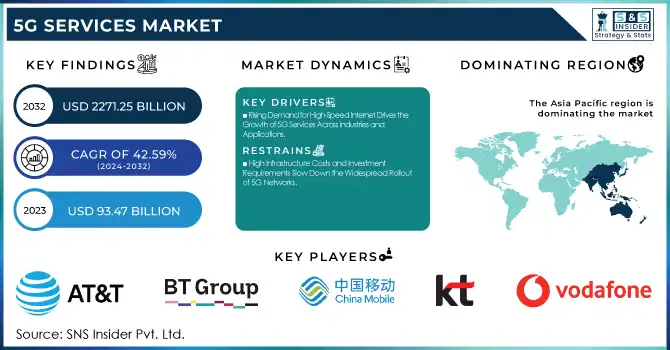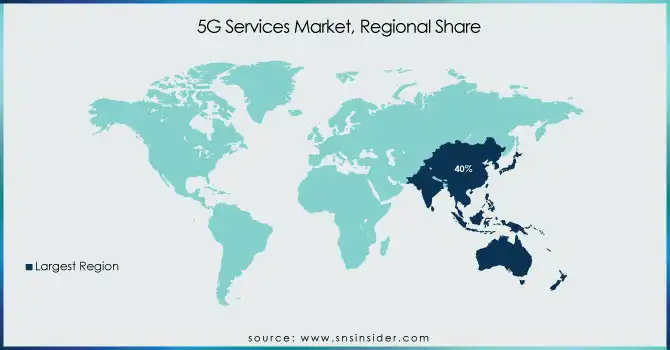5G Services Market Report Scope & Overview:
The 5G Services Market was valued at USD 93.47 billion in 2023 and is expected to reach USD 2271.25 billion by 2032, growing at a CAGR of 42.59% from 2024-2032. This report includes insights into the adoption rates of emerging technologies, service usage patterns, and customer segmentation. It also covers the regulatory impact on the industry, which influences market dynamics, and examines the profound impact of 5G on latency and speed, enabling faster and more reliable connections. As 5G continues to expand, it promises to revolutionize connectivity and transform various industries.

Get more information on 5G Services Market - Request Sample Report
5G Services Market Dynamics
Drivers
Rising Demand for High-Speed Internet Drives the Growth of 5G Services Across Industries and Applications
As data-intensive applications such as 4K/8K streaming, virtual reality, and cloud computing are increasing, the requirement for faster internet connections has drastically increased. In this regard, traditional networks fail to meet these high-bandwidth applications, hence shifting towards new-generation connectivity solutions. 5G services serve as an ideal solution, which offers up to 20 Gbps peak data rates and average data rates above 100 Mbps, much more than 4G.These technologies present unprecedented download and upload speeds, lower latency, and higher reliability. Such improvements are important to both consumers and businesses as it allows for smoother experiences on all mobile devices, increases productivity, and enables newer technologies. It is this huge demand for fast internet access that will drive 5G service growth at breakneck speeds.
Restraints
High Infrastructure Costs and Investment Requirements Slow Down the Widespread Rollout of 5G Networks
The deployment of 5G networks requires a massive upfront investment in infrastructure, including the installation of new towers, small cells, and upgraded equipment. These costs are particularly high due to the need for densification of the network, as 5G relies on smaller cell towers to ensure adequate coverage and speed. In December 2024, Bharti Airtel signed a multi-billion-dollar deal with Ericsson to enhance its 4G and 5G networks in India. This upgrade further adds to the financial burden, as telecom companies must also upgrade existing network components to handle 5G’s advanced technology. Such substantial capital expenditures can delay the rollout of 5G services, particularly in regions with budget constraints or lower population density, creating barriers for widespread adoption of 5G technology.
Opportunities
Rapid Growth of IoT Devices Across Multiple Sectors Creates Strong Demand for 5G Connectivity and Real-Time Data Exchange
Rapidly growing smart homes, cities, healthcare, and industries create huge demand for the Internet of Things, driving high demands for more connectivity. Increasing the number of connected devices also leads to higher demands for speed, reliability, and scalability of the networks. Massive device connectivity, ultra-low latency, and high bandwidth supported by 5G make it perfectly apt to fulfill such demands. From smart homes with interconnected appliances to smart cities with integrated infrastructure, 5G enables seamless data exchange and real-time communication between devices. In healthcare, IoT-powered devices rely on 5G for remote monitoring and telemedicine, while industries benefit from automation and efficient supply chain management, unlocking new growth potential in various sectors.
Challenges
Limited Spectrum Availability and Complex Regulatory Processes Slow Down the Deployment of 5G Networks Across Regions
Availability of appropriate spectrum is one of the major challenges for the rapid rollout of 5G networks. In many areas, the needed spectrum frequencies are either scarce or already in use by other services, and telecom operators find it challenging to acquire the required licenses. Moreover, the process of spectrum allocation by the regulatory authorities is time-consuming and complex, which further slows down the roll-out of 5G networks. High costs associated with spectrum-license acquisition put pressure on operators in terms of finance, and the process becomes quite challenging and even unbearable for smaller players who can't afford competitive bidding processes. All these factors present a hindrance towards faster deployment of 5G networks, further slowing down the market growth and the eventual nationwide consumption of highly-demanding services.
5G Services Market Segment Analysis
By Vertical
The Enterprises segment led the 5G Services Market with a largest revenue share of about 87% in 2023, as their adoption of 5G supports enhanced connectivity, automation, and digital transformation of various industries. On the other hand, Consumer is expected to grow at a CAGR of about 48.01% from 2024-2032, considering the increasing adoption of high-speed internet, smart devices, as well as immersion applications such as gaming and AR/VR.
By Application
The Entertainment & Immersive Tech segment dominated the 5G Services Market with the highest revenue share of about 32% in 2023, led by growing high-quality streaming, gaming, and AR/VR experiences. The Industrial & Enterprise segment has the potential to grow at the fastest CAGR of about 45% during 2024-2032, led by an increasing adoption of 5G for automation, real-time data analytics, and smart manufacturing in various industries.
By Communication Type
The eMBB segment dominated the 5G Services Market with a revenue share of around 49% in 2023, mainly due to the growing demand for high-speed internet, video streaming, and immersive media experiences. On the other hand, the uRLLC segment is likely to expand at the fastest CAGR of about 45.84% during the forecast period of 2024-2032, driven by the increasing need for real-time applications in autonomous vehicles, healthcare, and industrial automation.
Regional Analysis
Asia Pacific dominated the 5G Services Market with a revenue share of about 40% in 2023. The region had been rapidly upgrading its technology, and large-scale 5G deployments had helped the region get widespread coverage. Countries like China, South Korea, and Japan have made big investments in 5G infrastructure, and increasing demand for high-speed internet and government initiatives for digital transformation has further helped solidify Asia Pacific's position at the top of the market.
North America is expected to grow at the fastest CAGR of approximately 44.73% during the forecast period from 2024-2032, driven by strong investments in 5G infrastructure and innovation in technology. High adoption of 5G services is driven by advancements in the telecom networks of the region along with a high level of industrial automation and use of IoT. The growth across enterprises within industries in healthcare, automotive, and manufacturing sectors would continue boosting the pace in the coming years in North America.

Need any custom research on 5G Services Market - Enquire Now
Key Players
-
AT&T, Inc. (AT&T 5G, AT&T Multi-Access Edge Computing)
-
British Telecommunications plc (EE 5G, BT Cloud Work)
-
China Mobile Ltd. (5G SA Network, Mobile Cloud)
-
China Telecom Corporation Ltd. (Tianyi Cloud, 5G Private Network)
-
Bharti Airtel Limited (Airtel 5G Plus, Airtel IoT)
-
KT Corp. (KT 5G, GiGA Genie)
-
Saudi Telecom Company (stc 5G, stc IoT)
-
Vodafone Group Plc (Vodafone 5G, Vodafone Edge Innovation)
-
Deutsche Telekom AG (Magenta 5G, Campus Network)
-
SK Telecom Co., Ltd. (SKT 5G, Metaverse Platform ifland)
-
Verizon Communications, Inc. (Verizon 5G Ultra Wideband, 5G Edge)
-
NTT DOCOMO (docomo Open RAN, 5G XR)
-
T-Mobile USA, Inc. (T-Mobile 5G, 5G Advanced Network Solutions)
-
Rakuten Mobile Inc. (Rakuten 5G, Rakuten Symphony)
-
Orange (Orange 5G, Livebox 5G)
-
China Unicom (5G Industry Solutions, Unicom Cloud)
-
Telstra Group (Telstra 5G, Telstra Edge)
-
Rogers Communications (Rogers 5G, Rogers Business IoT)
-
Bell Canada (Bell 5G, Bell Cloud Connect)
-
Etisalat (Etisalat 5G, Etisalat OneCloud)
-
KDDI Corporation (au 5G, KDDI IoT World)
-
Telus Corporation (Telus 5G, Telus Smart Cities)
-
LG Uplus Corporation (LG U+ 5G, U+ Smart Home)
-
Swisscom (Swisscom 5G, Swisscom Edge)
-
Reliance Jio Infocomm (Jio True 5G, Jio Cloud)
-
Telenor Group (Telenor 5G, Telenor Managed IoT)
-
MTN Group (MTN 5G, MTN IoT Solutions)
-
Dish Network Corporation (Dish 5G, Boost Infinite)
-
Telefonica S.A (Movistar 5G, Telefonica Edge Computing)
-
JMA Wireless (XRAN, CellHub)
-
Verana Networks (Verana 5G RAN, Verana Small Cells)
-
Celona (Celona 5G LAN, Celona Edge)
-
Mangata Networks (Mangata 5G, Mangata Edge Cloud)
-
Airspan Networks (Airspan OpenRANGE, Airspan 5G RAN)
-
EdgeQ (EdgeQ 5G Baseband, EdgeQ AI-RAN)
-
Omniflow (Omniflow Smart Pole, Omniflow 5G Hub)
-
Aarna Networks (Aarna Edge Services, Aarna 5G Orchestration)
Recent Developments:
-
In February 2025, AT&T signed a multi-year agreement with Nokia to enhance its voice services and 5G network automation. This deal follows Nokia’s previous loss of a large contract to Ericsson but still strengthens its role in AT&T's network, focusing on cloud-based voice services and AI integration.
-
In March 2024, BT Group announced its plans to launch a 5G Standalone network, marking a significant step forward in the UK's 5G evolution. This new network will offer enhanced capabilities and efficiency, positioning BT as a key player in the next phase of 5G deployment
-
In February 2025, Celona and HCLTech formed a partnership to deliver advanced private 5G solutions. The collaboration aims to provide enterprises with secure, high-performance 5G networks for critical applications
| Report Attributes | Details |
|---|---|
| Market Size in 2023 | USD 93.47 Billion |
| Market Size by 2032 | USD 2271.25 Billion |
| CAGR | CAGR of 42.59% From 2024 to 2032 |
| Base Year | 2023 |
| Forecast Period | 2024-2032 |
| Historical Data | 2020-2022 |
| Report Scope & Coverage | Market Size, Segments Analysis, Competitive Landscape, Regional Analysis, DROC & SWOT Analysis, Forecast Outlook |
| Key Segments | • By Communication Type (Fixed Wireless Access (FWA), Enhanced Mobile Broadband (eMBB), Ultra-Reliable and Low-Latency Communications (uRLLC), Massive Machine-Type Communications (mMTC)) • By Vertical (Consumer, Enterprises) • By Application (Smart Infrastructure, Industrial & Enterprise, Automotive & Mobility, Healthcare & Well-being, Entertainment & Immersive Tech) |
| Regional Analysis/Coverage | North America (US, Canada, Mexico), Europe (Eastern Europe [Poland, Romania, Hungary, Turkey, Rest of Eastern Europe] Western Europe] Germany, France, UK, Italy, Spain, Netherlands, Switzerland, Austria, Rest of Western Europe]), Asia Pacific (China, India, Japan, South Korea, Vietnam, Singapore, Australia, Rest of Asia Pacific), Middle East & Africa (Middle East [UAE, Egypt, Saudi Arabia, Qatar, Rest of Middle East], Africa [Nigeria, South Africa, Rest of Africa], Latin America (Brazil, Argentina, Colombia, Rest of Latin America) |
| Company Profiles | AT&T, Inc., British Telecommunications plc, China Mobile Ltd., China Telecom Corporation Ltd., Bharti Airtel Limited, KT Corp., Saudi Telecom Company, Vodafone Group Plc, Deutsche Telekom AG, SK Telecom Co., Ltd., Verizon Communications, Inc., NTT DOCOMO, T-Mobile USA, Inc., Rakuten Mobile Inc., Orange, China Unicom, Telstra Group, Rogers Communications, Bell Canada, Etisalat, KDDI Corporation, Telus Corporation, LG Uplus Corporation, Swisscom, Reliance Jio Infocomm, Telenor Group, MTN Group, Dish Network Corporation, Telefonica S.A, JMA Wireless, Verana Networks, Celona, Mangata Networks, Airspan Networks, EdgeQ, Omniflow, Aarna Networks. |

